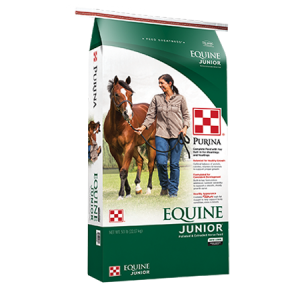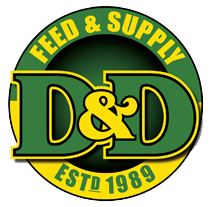Purina Equine Junior Horse Feed

Purina Equine Junior Horse Feed takes the guesswork out of feeding your growing horse. Proper growth and development depend upon strong genetics, a nurturing environment, and good nutrition.
Developed to give your young horse a strong head start with the proper balance of nutrients. Promotes optimal growth and development. Purina Equine Junior Horse Feed is a complete feed. As a result, high-quality forage is built-in, eliminating nutrient variability of hay or pasture. Promotes a consistent diet for weanlings and yearlings.
Formulated with Purina’s proprietary high-fat Amplify nugget—a blend of vegetable oils, flaxseed, and rice bran for an optimal fatty acid profile—to support development, shine, and bloom.
Have questions about our equine feed and supplement products? The friendly staff at D&D Feed & Supply is here to help you find the right products. Contact us or visit our local store in Tomball, Texas.
Guaranteed Analysis
Crude Protein (min)............................................14.50 %
Lysine (min)............................................................0.80 %
Methionine (min)....................................................0.25 %
Threonine (min)......................................................0.55 %
Crude Fat (min)......................................................5.50 %
Crude Fiber (max)...............................................16.00 %
Starch (max)..........................................................14.00 %
Sugars (max)..........................................................9.00 %
Calcium (Ca), (min)..............................................0.80 %
Calcium (Ca), (max)...............................................1.30 %
Phosphorus (P), (min)..........................................0.55 %
Copper (Cu), (min)...................................... 60.00 ppm
Selenium (Se), (min)...................................... 0.30 ppm
Zinc (Zn), (min).......................................... 220.00 ppm
Vitamin A (min) ............................................3500 IU/lb
Vitamin D3 (min) ............................................. 600 IU/lb
Vitamin E (min) .................................................150 IU/lb
Feeding
| Light Breeds (Estimated mature weight of approximately 1,000 lbs.) | Weight of Horse in Pounds | |||||||||
| 300 | 400 | 500 | 600 | 700 | 800 | 900 | 1,000 | |||
| Lbs/day of Equine Junior® Horse Feed (When fed as a complete feed without roughage) | ||||||||||
| Moderate Growth | 10 | 11 | 11.5 | 12.75 | 14 | 14.5 | 15.25 | 15.75 | ||
| Rapid Growth | 11.25 | 12 | 14 | 15.5 | 16.5 | 17 | 17.25 | 17.5 | ||
| Large Breeds (Estimated mature weight of approximately 1,500 lbs.) | Weight of Horse in Pounds | |||||||||
| | | 600 | 700 | 800 | 900 | 1,000 | 1,100 | 1,200 | 1,300 | 1,400 | 1,500 |
| Moderate Growth | 14 | 15.5 | 17 | 18 | 19 | 20 | 21 | 22.25 | 23.5 | 24.5 |
| Rapid Growth | 15.25 | 17 | 19 | 20.5 | 22 | 23.25 | 24.5 | 25 | 25.5 | 26 |
- Equine Junior horse feed is designed to be fed as a complete feed. If necessary, you may also feed with good-quality hay or pasture, up to a maximum of 5 pounds per day, to relieve boredom.
- You should reduce the amount of Equine Junior horse feed fed by 1 pound for every 1.5 to 2 pounds of hay offered.
- For best results, do not feed more than 1 pound of hay per 100 pounds of your horse's body weight when feeding Equine Junior horse feed.
- Feeding rates will vary with size, age, temperament, health status, climate and activity level. Feed at regular times - at least twice daily - with three daily feedings preferred. Let horses feed in a natural position from troughs with large bottoms, placed at normal head height or lower. Do not feed free-choice. Prevent the rapid eating by the horse of any feedstuff.
- Reduce and/or delay feeding a horse which is hot, excited or showing pain, has fever or diarrhea. Consult your veterinarian if any problems arise.
- Any feed changes should be made gradually over a period of 7 to 10 days. Changes in the rate of feeding should not exceed 1.0 lb per day for each horse.
- Have plenty of clean, fresh water available at all times. Provide your horse with access to salt. Maintain an effective control program for internal parasites. Have the horse's teeth examined annually and consult your veterinarian on a regular basis.
- Make the feed change gradually over a period of 7 to 10 days
- Mix the new feed with the old, gradually increasing the amount of the new feed while decreasing an equal amount of the old.
- Changes in the rate of feeding should not exceed 1 pound per day for each horse.
